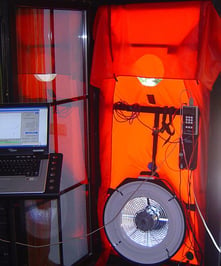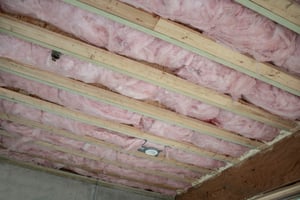I’m Ellen- I’m in my thirties and I (along with my husband) am a first-time homeowner! I also happen to work for Viessmann, a leading company in effective, economical heating systems. As their “Consumer Specialist” and writer, I’m supposed to tell you, the other homeowners out there, how to best keep your house cozy and warm without breaking the bank. One problem - our house, a 1910 Cape Cod, was not warm, forget about cozy. During the coldest streak of the winter, when temperatures here in Rhode Island were stuck below zero, you could find me on the couch, stacking blankets on blankets while seeing if I could fit another pair of socks on my feet. The main living spaces struggled to hit the mid 50’s, bottoming out at a miserable 48º in the living room. Houseplants died from the cold, I died on the inside, and our living room began to take on the form of a textile factory.
their “Consumer Specialist” and writer, I’m supposed to tell you, the other homeowners out there, how to best keep your house cozy and warm without breaking the bank. One problem - our house, a 1910 Cape Cod, was not warm, forget about cozy. During the coldest streak of the winter, when temperatures here in Rhode Island were stuck below zero, you could find me on the couch, stacking blankets on blankets while seeing if I could fit another pair of socks on my feet. The main living spaces struggled to hit the mid 50’s, bottoming out at a miserable 48º in the living room. Houseplants died from the cold, I died on the inside, and our living room began to take on the form of a textile factory.
As you might expect, one does not become a writer at a heating company without a high level of nerd-ery, and my special sort includes a habit of super-scale research rabbit holes. I scoured the web, spoke with our team of engineers, and sat down with heating contractors I’ve been lucky enough to meet about different ways to keep our home warm in the winter. I learned some tried-and-true weatherization techniques and I got to work. Spray-foam insulation: check. Weatherstripping on the doors and plastic on the windows: double-check. But still, our blanket pile grew and desperation kicked in. Even with space heaters added to the permanent decor of the bathroom, bedroom, and living room, we were still cold.
When checking out how high the month’s gas bill would be, despite the brand new boiler in the basement (#notsponsored), I looked around the utility company’s website for more advice, and found an offer for a home energy assessment. Our local gas company offered them for free, so I called to set up an appointment. Before they arrived, they gave me a list of things to have ready, including a few past utility bills for reference, access to the basement and attic, and the suggestion to tuck the pets away for safety. When they arrived, two friendly men set up a full office at my kitchen table, (printer and all!) and asked some easy questions about the house, the heating bills, comfort level, etc. Next, one of the workers measured inside and out, creating a  diagram of the house, while the other used a few James Bond-level gizmos and gadgets to gauge drafts, airflow through the house, and the insulation - or lack thereof! They discovered the source of our frigid winter was that not a stitch of insulation existed past the spray foam we applied during my research-inspired weatherization rampage.
diagram of the house, while the other used a few James Bond-level gizmos and gadgets to gauge drafts, airflow through the house, and the insulation - or lack thereof! They discovered the source of our frigid winter was that not a stitch of insulation existed past the spray foam we applied during my research-inspired weatherization rampage.
After they completed their tests, replaced all our light bulbs with free LED replacements, and showed us how to use our free new energy-efficient power strips, a few other fixes were recommended, like venting the bathroom fan outside and adding some ventilation to the attic. The diagram they created of our home was mocked up to show where insulation should be added for maximum coziness (and I guess environment friendliness…). Before they left I had a contract in hand with all their recommendations and the time each would take for each to pay for themselves (in terms of future cost-savings). Best of all - the utility company would cover about 70% of the costs! The price we were left to pay for everything recommended was beyond reasonable for such a huge increase in our home’s comfort and efficiency. On top of everything, a no-interest loan for 36 months to cover the remaining ~$2,000 cost due - a bargain!
Once we signed the contract and tied up a few loose ends (our house had old knob and tube wiring that needed inspection to make sure it was not hooked up to anything), the utility company took care of the rest- they hired the contractors, sent them the plans, and set up the work. Over the course of two days, our house was insulated from top to bottom. First, when the team of insulating experts arrived, they headed up to the attic, where they added rolls of fiberglass insulation to the floor, which will keep the heated (or cooled!) air from escaping through the roof. Next, they carefully removed sections of our vinyl siding and drilled small holes in the wood between each and every framing stud and used those holes to blow insulation into the walls from the foundation up to the attic line. Each hole was carefully filled and covered with insulating tape, and the siding was replaced; wandering around after they left for the day, I couldn’t tell what they had touched! On day two, the team arrived once again, this time to tackle the basement. More rolls of fiberglass insulation were hauled inside, these were added in-between the floor joists in the basement ceiling. With that, the work was complete.
took care of the rest- they hired the contractors, sent them the plans, and set up the work. Over the course of two days, our house was insulated from top to bottom. First, when the team of insulating experts arrived, they headed up to the attic, where they added rolls of fiberglass insulation to the floor, which will keep the heated (or cooled!) air from escaping through the roof. Next, they carefully removed sections of our vinyl siding and drilled small holes in the wood between each and every framing stud and used those holes to blow insulation into the walls from the foundation up to the attic line. Each hole was carefully filled and covered with insulating tape, and the siding was replaced; wandering around after they left for the day, I couldn’t tell what they had touched! On day two, the team arrived once again, this time to tackle the basement. More rolls of fiberglass insulation were hauled inside, these were added in-between the floor joists in the basement ceiling. With that, the work was complete.
After completing the insulation install, the tests performed during the energy audit were repeated, and our draft test was cut by more than half! A great sign that the house was sealed up and holding onto the air inside instead of letting it slip out through the roof, walls, and windows. After retesting everything, the contractors cleaned up and headed out. Being summer, we weren’t able to notice a difference in heating, but for the first time since owning the home, we had to turn the air conditioner down! The insulation instantly made a difference in maximizing the efficiency of the cooling system. The most surprising difference we found was the decrease in the noise level from outside; our corner-facing lot is typically quite noisy from cars, trucks, and the occasional tractor heading down the street. Now, it’s work to listen for the traffic as it passes by!
 All in all, the biggest thing I’ve learned is that when it comes to heat, the boiler isn’t the most important piece of the puzzle; it’s the full package. Even with our brand new heating system, it still took a lot of work to ensure our comfort at home. Now with our insulation, weather protection, and boiler combined, we’re ready to take on our second winter with confidence. For the first time ever, I’m excited for the weather to cool down so we can get a gauge of the full effects of the insulation in action. I guess our next project will be to build a cedar chest to store our massive blanket collection... time for the next research binge!
All in all, the biggest thing I’ve learned is that when it comes to heat, the boiler isn’t the most important piece of the puzzle; it’s the full package. Even with our brand new heating system, it still took a lot of work to ensure our comfort at home. Now with our insulation, weather protection, and boiler combined, we’re ready to take on our second winter with confidence. For the first time ever, I’m excited for the weather to cool down so we can get a gauge of the full effects of the insulation in action. I guess our next project will be to build a cedar chest to store our massive blanket collection... time for the next research binge!
To find out about getting a home energy assessment in your area, contact your state government’s energy offices or your local energy utility company
